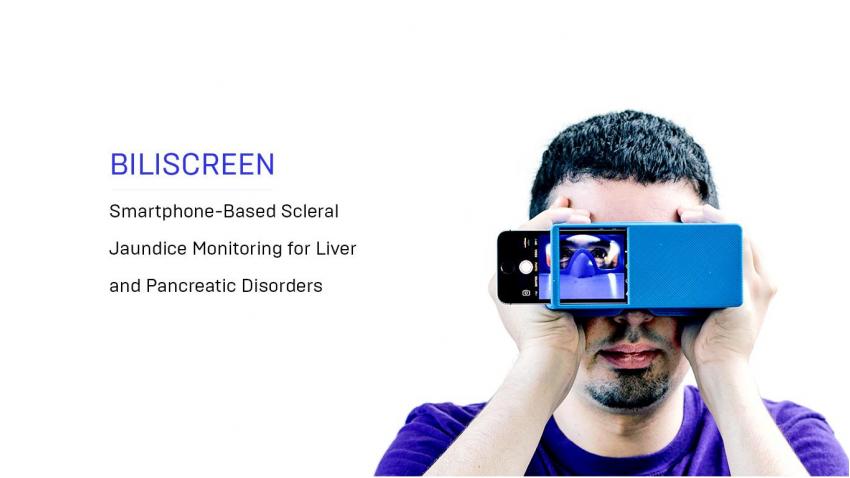Pancreatic cancer diagnostics with the help of a mobile app
Pancreatic cancer is a severe disease usually with an unfavorable chances of survival. Pancreatic cancer ranks fourth among cancer diseases of the gastrointestinal tract. Five-year survival rate after treatment is only 9%. The reason for this is that pancreatic cancer is mostly detected at advanced stages when it is almost impossible to treat it. As a rule the disease develops painlessly and the symptoms which help to reveal it appear when the tumor goes beyond the limits of the affected organ. Hence nowadays the development of effective methods of screening for pancreas tumors is extremely important.
Jaundice is one of the first indicators of pancreatic cancer and other diseases of the hepatobiliary system. The disease is characterised by a yellow discoloration of the skin, sclera and mucous membranes and develops due to increased bilirubin levels in blood. The ability to detect jaundice when bilirubin levels are slightly increased and before the disease symptoms are visible to the naked eye – would give the opportunity to begin effective screening for people at high risk.

That is why Washington researches decided to develop an application that could easily and effectively reveal pancreatic cancer using selfie, which is very familiar to modern people.
BiliScreen Overview
BiliScreen is an application that works with the help of a mobile phone camera, specially developed algorithms and mechanisms that can reveal increased bilirubin levels in sclera. The development was introduced to the public on the 13th of September at Ubicomp World Congress in 2017.
BiliScreen was invented on the basis of earlier studies of Ubiquitous Computing Lab which previously developed BiliCam – an app which makes it possible to diagnose jaundice in newborns by taking a photo of a baby's skin. The research work, recently published in the journal Pediatrics, proved that BiliCam accurately estimated bilirubin levels in 530 children.
UbiComp Laboratory together with scientists from the University of Washington use microphones, cameras and many other gadgets in their researches to screen for various diseases.

How does the app work?
- BiliScreen uses a smartphone’s camera and flash card to collect selfies of eyes.
- A special system automatically separates sclera as its color is very important for the research.
- Then the app calculates the color information from the sclera, which is based on the wavelengths of light – and compares this information with bilirubin levels.
In order to create the ideal lighting conditions for the research the team tested the BiliScreen app with two accessories: paper glasses with colored squares to enable better color calibration and a 3-D printed box.
Carrying out the research with the box, which blocks external lighting and looks similar to a Google Cardboard accessory, provided much more accurate results.
In particular, the diagnostics of 70 patients showed cases of concern with 89.7% accuracy in comparison with the currently used blood test.
Alex Mariakakis, one of the leading BiliScreen developers, believes that the main problem of pancreatic cancer is as follows: visible symptoms appear too late for the possibility of effective treatment. The researchers hope this app will enable people to do the test at least monthly at their homes. Consequently, this could help to reveal the disease much faster and would give the opportunity to start treatment on time, thus saving a lot of lives.
App advantages
The BiliScreen app is a non-invasive tool for estimating bilirubin levels which is affordable and does not cause any discomfort. The app helps to diagnose hepatitis, and Gilbert's syndrome at early stages and to control pancreatic cancer development. The change of skin color is one of the first symptoms of these diseases, however sclera is more sensitive to increased bilirubin levels compared to skin. In contrast to skin color, which can not be adequately assessed in all ethnic groups and races, sclera colour evaluation is suitable for all patients.
Professor Shwetak Patel, the member of the Washington Research Foundation Entrepreneurship, said: «The eyes are a very interesting part of our body: tears can show how much glucose you have in your body and sclera color can tell you how much bilirubin is in your blood. That is why we pondered the dilemma: Is it possible to capture the changes that will lead to earlier detection of the disease with a selfie?»
Plans of the research team
Testing the app on a wider range of people is the next goal for the research team. The team also plans to improve the app so that people do not need to use additional accessories, such as glasses and a special box.

One of the co-authors of the study, Jim Taylor, whose father died of pancreatic cancer, said: «Nowadays the humanity does not have an effective screening method for such a terrible disease as pancreatic cancer. Our goal is to help more people, who are unfortunate enough to be diagnosed with pancreatic cancer, to detect their disease on time and receive an appropriate treatment with high chances of survival».
10.03.2018